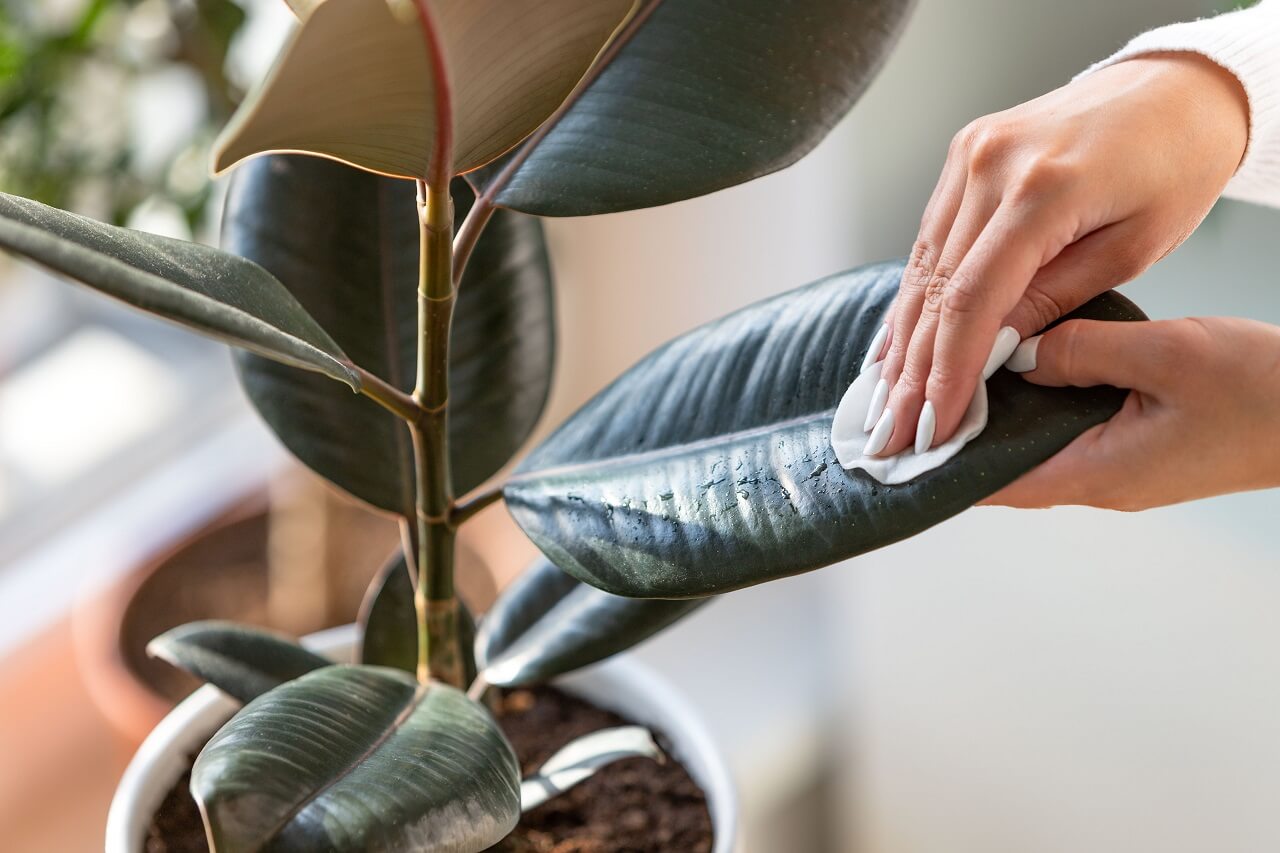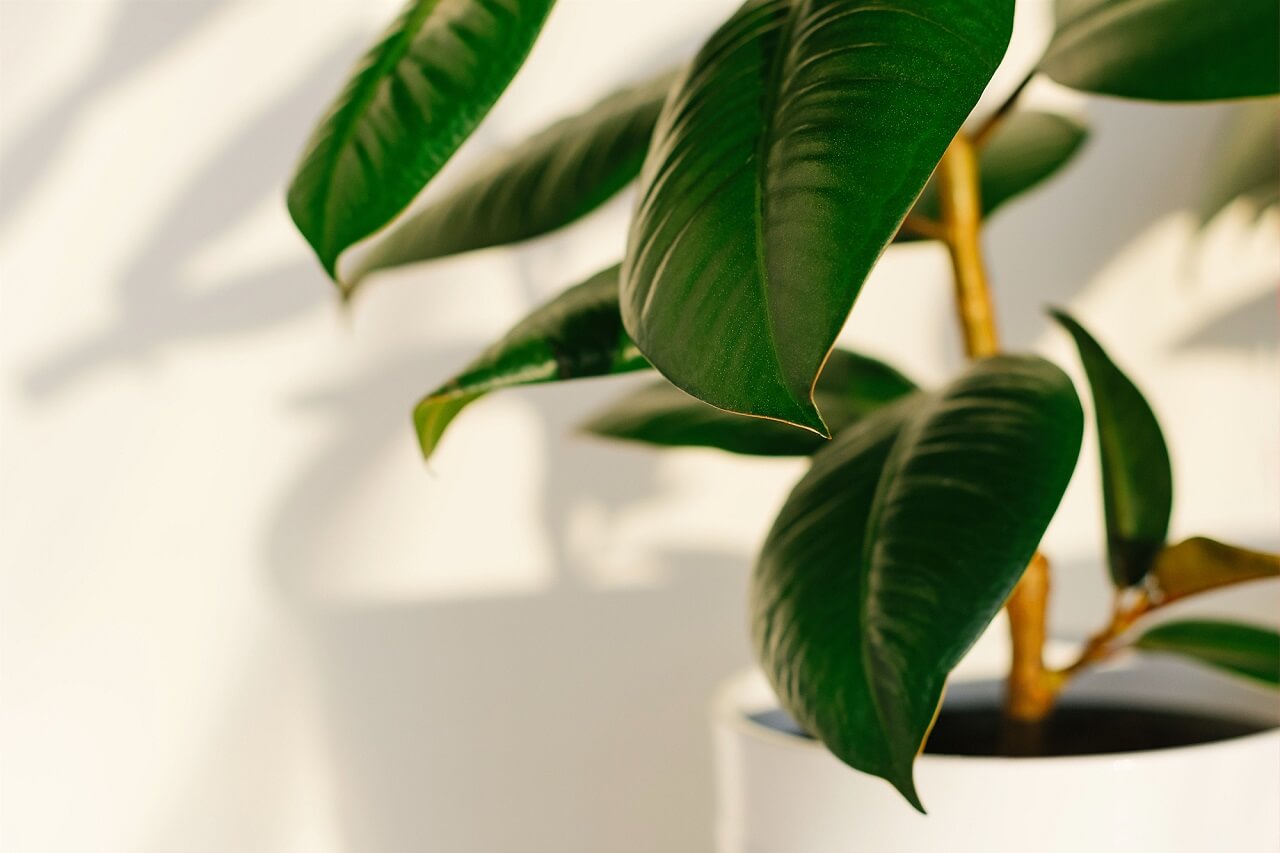Ficus elastica, or rubber plants, are easygoing plants that are well-suited for novice and expert gardeners alike. They come in a wide range of sizes and colors and are known for their stiff, shiny leaves. Like any houseplant, rubber plants do have certain preferences that might make it difficult for them to thrive in certain environments. In this article, we’ll talk about how to help your rubber plant live its best life.
What You'll Learn Today
How Do You Care For Indoor Rubber Plants?

As with most houseplants, the best way to keep a rubber plant happy is by striking a good balance of water and sunlight. But to see your plant truly shine, there are several other factors to consider:
Water
Rubber plants like their soil to be consistently moist, but not too soggy. In general, when the top few inches of soil are dry and crumbly, it’s time to water. Depending on the conditions in your home, this usually ends up being around once per week during the growing season.
Soil moisture levels can be tough to master, but your plant will show you signs when its water requirements are not being met.
For example, yellowing leaves and leaves falling off are common signs of an overwatered rubber plant. On the flip side, if the leaves are wilted and browning, your plant is probably thirsty.
When you water your rubber plant, water it thoroughly until it drains from the pot. When it’s done draining, empty the tray or saucer that the pot rests on since they don’t like sitting in water.
Keep in mind that rubber plants’ water requirements diminish in the winter when they are dormant. Since they won’t use up water as quickly, you’ll probably find that once per month waterings are more appropriate during this time.
Light
Rubber plants love bright, indirect light. When they aren’t receiving enough light, they often start to get leggy, drop their leaves, and their color won’t be as vibrant.
Variegated rubber plants can even tolerate some soft, morning sun, as this helps bring out the color in the leaves. No rubber plant should ever be placed directly in the harsh, afternoon sun, however.
Soil
Rubber plants aren’t particularly fussy about the type of soil they live in. Any all-purpose potting mix will do, as long as it drains well.
You might find notice over time that the soil level will go down and their roots will start to show. This is because rubber plants slowly consume their soil. If the roots of your plant start to show, just top it off with some more soil.
Temperature
The ideal temperature for a rubber plant is around 60-65 degrees Fahrenheit at night, and 75-80 degrees Fahrenheit during the day. They start showing signs of unhappiness when temperatures are consistently under 55 degrees Fahrenheit.
Rubber plants also show signs of stress when temperatures vary dramatically, like when they are exposed to cold drafts.
Humidity
Rubber plants are native to the tropical areas of Nepal, China, and Western Malesia, where they enjoy high humidity levels. If you can maintain a higher level of humidity around your plant, you’ll likely see great results.
However, lower humidity isn’t typically a dealbreaker for rubber plants. Most of them are content with humidity levels around 40-50%.
Fertilizer
Rubber plants appreciate regular feedings during the growing season but do not like to be overfed. A water-soluble, all-purpose houseplant fertilizer will suffice and can be given about once every two weeks during the spring and summer.
If your plant is kept in lower light, you should fertilize less often.
Where Should I Place a Rubber Plant in My House?

As stated above, rubber plants do best in bright, indirect light. Placing them near a window in an eastern window puts them in the ideal position. This will allow for some gentle morning sun and indirect sun the rest of the day.
If it makes more sense for you to keep them near a southern window, place them far enough away from the window so that the sun won’t be directly on them. You can also hang a sheer curtain in the window to filter the sunlight.
If you only have a low light area to keep your plant, you can still make it work. An inexpensive full-spectrum light bulb designed for indoor plants placed in a lamp that can be clipped or positioned above the rubber plant for a few hours per day should simulate the proper amount of daylight.
How to Make Rubber Plant Leaves Shine
Some people start to notice that the leaves of their rubber plants lose some of their shine over time. When this happens, it’s usually due to one of these issues:
- Your plant isn’t getting enough light: If your rubber plant is getting leggy, losing its lower leaves, and generally looking dull, it probably just needs more light. Try giving them a little bit of indoor morning sun or placing them closer to a window.
- Your plant needs a bath: The big, beautiful foliage on a rubber plant means there is more surface area for dust to settle. Even the thinnest layer of dust on your plant can obstruct photosynthesis, hinder growth, and leave it looking sad. Wipe the leaves of your rubber plant with some warm, soapy water regularly to keep it looking glossy.
How to Make a Rubber Plant Bushy
Rubber plants can reach impressive vertical heights – up to 10 feet indoors, in some cases. If you’d prefer your plant to branch out, rather than up, you’ll need to prune it.
To prune the plant, first decide how tall you want it to be. When you cut the main stem, it won’t grow any higher and will be encouraged to branch out instead.
When you’re ready to cut, take some clean garden shears and trim the stem just above a node, which is the little bump where another leaf or stem will grow out of. You can also trim any of the stems that branch out of the rubber plant to achieve the shape you want.
For more helpful tips, check out this YouTuber give an overview of rubber plant care:
The short list of a rubber plant’s demands makes it a wonderful plant to keep around. While it may take some time for you to get to know your plant and figure out the perfect growing conditions, it will all be worth it when you’re rewarded with big, beautiful growth.
Rubber Plant Key Facts
| Botanical Name | Ficus elastica |
| Common Names | Rubber plant, rubber tree, rubber fig |
| Type of Plant | Evergreen shrub/tree |
| Origin | Nepal, China, Western Malesia |
| Sun Requirements | Bright, filtered sunlight, more for variegated varieties |
| Water Requirements | Moderately moist soil, water when the top 2-3 inches of soil are dry to the touch |
| Soil | Chunky, well-draining organic potting mix |
| Bloom Time | Flowers rarely appear indoors |
| Common Pests | Fungus gnats, spider mites, mealybugs |
Is a Rubber plant’s sap toxic?
This plant has a milky sap that is mildly irritating to the skin, and can cause gastrointestinal issues if ingested. Try to keep your Rubber Plant away from babies and pets.